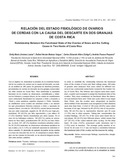| dc.rights.license | http://creativecommons.org/licenses/by-nc-sa/3.0/ve/ | |
| dc.contributor.author | Jiménez Loaiza, Emily María | |
| dc.contributor.author | Mateus Vargas, Rafael Hernán | |
| dc.contributor.author | Alfaro Zúñiga, Carlos Eduardo | |
| dc.contributor.author | Passos Pequeno, Andréia | |
| dc.date.accessioned | 2012-09-12T16:33:44Z | |
| dc.date.available | 2012-09-12T16:33:44Z | |
| dc.date.issued | 2012-09-12T16:33:44Z | |
| dc.identifier.issn | 0798-2259 | |
| dc.identifier.uri | http://www.saber.ula.ve/handle/123456789/35880 | |
| dc.description.abstract | Con el objetivo de determinar la relación de la condición funcional
de los ovarios de cerdas con la causa del descarte, se realizó
un análisis de 260 pares de gónadas de hembras porcinas,
provenientes de cerdas de descarte de dos granjas comerciales
del Valle Central de Costa Rica. Para determinar la condición
funcional de los ovarios se observaron, contabilizaron y midieron
los folículos y cuerpos lúteos, de los cuales se consideraron
como estructuras funcionales los mayores a 5mm y menores a
15mm y como quísticos, aquellos mayores a 15mm. Además,
se clasificaron como ovarios sin actividad cíclica o en anestro
los que presentaron folículos menores a 5mm y ausencia de
cuerpos lúteos. Un total de 106 (40,8%) cerdas fueron descartadas
por edad avanzada, seguido de 66 (25,4%) por baja productividad,
58 (22,3%) por fallo reproductivo y por ultimo 30
(11,5%) hembras fueron desechadas por otras causas. En el
caso de los hallazgos ováricos, 138 (53,1%) cerdas se encontraron
en fase lútea, posteriormente 89 (34,2%) en fase folicular,
es decir, 227 (87,3%) hembras mostraron actividad cíclica.
En 28 (10,8%) animales se observaron estructuras quísticas en
sus ovarios y en 5 (1,9%) se evidenció ausencia de actividad cíclica
o anestro. El promedio de número de partos en las cerdas
a la hora del descarte fue de 5,5. Al relacionar el estado fisiológico
con las causas de descarte, no se observó ninguna asociación
entre ambas variables. | es_VE |
| dc.language.iso | es | es_VE |
| dc.rights | info:eu-repo/semantics/openAccess | |
| dc.subject | Porcino | es_VE |
| dc.subject | Hallazgos macroscópicos | es_VE |
| dc.title | Relación del estado fisiológico de ovarios de cerdas con la causa del descarte en dos granjas de Costa Rica | es_VE |
| dc.title.alternative | Relationship between the functional state of the ovaries of sows and the culling cause in two herds of Costa Rica | es_VE |
| dc.type | info:eu-repo/semantics/article | |
| dc.description.abstract1 | In order to establish the relationship between the functional
state of the ovaries of sows and their culling cause, 260 pairs
of gonads were analyzed from sows culled for different reasons
in two commercial swine herds located in the Central Valley
of Costa Rica. The follicles and corpora lutea were examined,
counted and measured to judge the functional state of the
ovaries. They were considered as functional when the diameter
was between 5mm and 15mm and cystic when it was larger
than 15mm, also the ovaries were categorized as inactive
when neither of the structures was recognized or their diameter
were less than 5mm. A total of 106 sows (40.8%) were culled
because of old age, followed by 66 (25.4%) due to low productivity,
58 (22.3%) due to reproductive disorder and 30 sows
(11.5%) owe to other reasons. Taking into consideration the
ovarian findings, 138 (53.1%) of the sows were found into luteal
phase, 89 (34.2%) into follicular phase, which means that
227 (87.3%) of the culled animals were cycling. On the other
hand, 28 sows (10.8%) possessed cystic structures and 5
(1.9%) were in anestrus. The average parity number at removal
for all sows 5.5. It was not found a correlation between
the functional state of the ovaries and the reasons for culling. | es_VE |
| dc.description.colacion | 341 - 347 | es_VE |
| dc.description.email | emilyjim.13@gmail.com | es_VE |
| dc.description.frecuencia | Bimestral | |
| dc.identifier.depositolegal | 199102ZU46 | |
| dc.subject.institucion | Universidad del Zulia (LUZ) | es_VE |
| dc.subject.institucion | Universidad de Los Andes (ULA) | es_VE |
| dc.subject.keywords | Swine | es_VE |
| dc.subject.keywords | Macroscopic findings | es_VE |
| dc.subject.publicacionelectronica | Revista Científica | |
| dc.subject.seccion | Revista Científica: Medicina Veterinaria | es_VE |
| dc.subject.thematiccategory | Medio Ambiente | es_VE |
| dc.subject.tipo | Revistas | es_VE |
| dc.type.media | Texto | es_VE |


